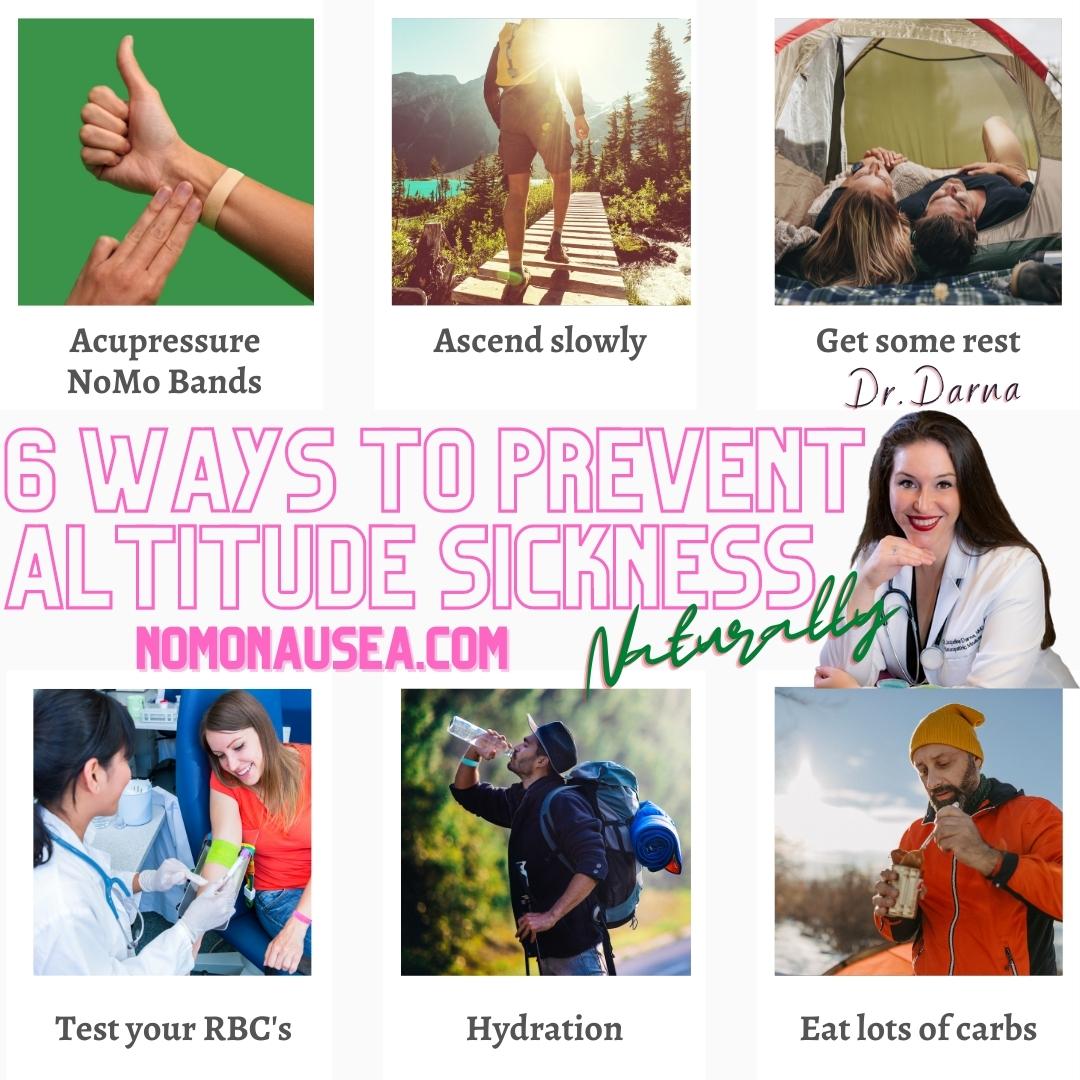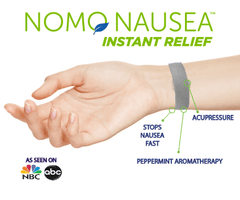
How to Prevent Altitude Sickness
Altitude or Elevation sickness is the bodies inability to adapt to a change in pressure and lack of oxygen. Side effects include nausea, headaches, and an overwhelming "bad" feeling. Imagine a fish guppy breathing for air, and now envision yourself on the ski slopes, now do you see the similarity? Avid skiers understand that enjoying the fresh powder, the speed beneath their feet, and the rush of the vertical drop is solely dependent on how they feel. And what's a vacation if you can't enjoy the plane ride or the final destination at high altitude? The NoMo Nausea Band is the first and only natural way to stop nausea and vomiting INSTANTLY for adults and kids too.

How to prevent altitude sickness?
Preventing altitude sickness is defined in 6 easy steps.
1. Ascend slowly: when traveling to place at high altitudes, your body typically needs 3 to 5 days at the altitude to acclimate to the environment before traveling higher. Try an altitude meter called an altimeter or a watch that shows the altitude you are traveling to know how high you've hiked. You can buy both an altimeter and a NoMo Nausea Band at most mountain sport shops but the easiest way is to buy here or on amazon.
Natural remedies for altitude sickness


The NoMo Nausea Band's 3 in 1 patent pending infusion of peppermint aromatherapy within a stylish and waterproof acupressure wristband has taken the world by storm and has won multiple awards. The peppermint aromatherapy within the band helps to calm active upset stomach in 30 seconds when smelled if motion sickness on the plane hits, or waves of nausea hit on the mountain top. This is also how NoMo Migraine helps to stop headaches by increasing oxygen, since the fastest way to the brain is thru the nose if their final destination is at a higher elevation than they are use to. Place the NoMo Nausea Band on the flight or the car ride and leave it in on the slopes to stop motion sickness, exercise induced nausea, and altitude sickness.
How high can you climb in altitude in 1 day?
Avid hikers known the simple do's and don'ts. Always remember to respect the mountain and altitude sickness is the least of your worries if you do not follow these altitude hiking guidelines.
- Do NOT go over 9000 feet in altitude in one day.
- Do not sleep 1000-2000 feet above the altitude you slept at the previous night.
- You should always spend an extra day acclimating for every 3300 ft.
2. Get rest: International travel, and even domestic flights, can change your normal sleep patterns. This is called jet lag. NoMo Sleepless Nights which puts you to sleep faster and keeps you asleep longer helps to increase your bodies melatonin production so it will help you to alter your sleep times as needed. Before you start your ascent up the mountain, plan a 1-2 day for rest. Use this to explore the area at the starting altitude, especially during your three to five day acclimation, make sure to get some sleep!

3. Test your red blood cells (RBC's): Before you leave for your trip known if you are anemic, or have low red blood cells. The number of red blood cells you have, called your hemoglobin, carry oxygen to your tissues and organ are needed for survival at higher altitudes. Low RBC's is most commonly due to iron deficiency or vitamin B deficiency. Both of which you can take supplements to help be successful before you travel and enter a lower oxygen air content.
4. Drink lots of water: Dehydration reduces the ability of your body to get use to new altitudes. Here's a few tips to help ensure your are well hydrated.
How much water should you drink before hiking at high altitudes?
- Make sure you drink at least 2-3L per day starting the day before your trip.
- Do not drink alcohol and avoid it the first 48 hours of your trip. Alcohol is a depressant which can slow down your breathing rate and cause dehydration. It also increases urination like "breaking the seal."
- Avoid caffeinated products like energy drinks and sodas because caffeine leads to dehydration of your muscles and makes you pee more.
5. Eat lots of carbs: High carbohydrate diets have shown in studies to alleviate acute mountain sickness symptoms and improve mood and performance according to Military Nutrition Research. Another study even shows carb loading improves oxygen saturation in the blood during simulated high altitude experiments.
What should you eat before hiking in high altitudes?
- pastas
- breads
- fruit
- potatoes
Avoid excess salt because salt dehydrates your body tissues. Try physical endurance and conditioning training too.

6. Acupressure: Using acupressure at the Nei-Guan or P6 point on the wrist helps to decrease the chance of getting altitude sickness. NoMo Nausea bracelets are the best remedy for altitude sickness because it is pressure and peppermint infused. It is an essential oil traveling band for altitude sickness!
The cooling effect of the peppermint essential oil helps the brain to focus on the temperature change of the band and not the stress of traveling, called Neuromodulation in medicine. Long lasting effects of acupressure at the specific P6 acupressure point found on the wrist produces happy hormones/anti-nausea hormones that can actually stop nausea before it starts! This is why celebrities sports stars are using the NoMo Nausea band to help increase performance, increase oxygenation during cardio, and help to enjoy hiking up mountains to the fullest.
Learn more about the one of a kind NoMo Nausea Band & purchase atwww.NoMoNausea.com. Or the NoMo Nausea Band can be found in CVS stores, select Harmon stores within Bed Bath & Beyond, on amazon, or at Stellar News Stands in airports across the country. Think of the vacations saved for an $12.99 purchase. Imagine a life with a family fun vacation, a comfortable plane ride, a healthy ski trip, or just a headache/migraine free day, that's what the NoMo Products can offer your readers while looking stylish too.


How to treat altitude sickness?
If natural remedies for altitude sickness do not work, try some prophylactic medication your doctor can order for you.
7. Acetazolamide: This is an FDA approved drug for the prevention of acute mountain sickness, especially if you are going to elevations higher than 8000 to 9000 feet. Take 125mg as prescribed twice daily starting 1 day before your trip and take 2 days at your highest altitude.
8. Dexamethasone: This is a steroid that studies have shown to reduce the incidence and severity of acute mountain sickness. Take 4mg every 6 to 12 hours as prescribed starting the day before your trip and continue until you are fully acclimated at your highest elevation.
9. Ibuprofen: Take 600mg of ibuprofen every 8 hours may also prevent altitude sickness
10. Ginkgo biloba has also been studies for the prevention of altitude sickness.
